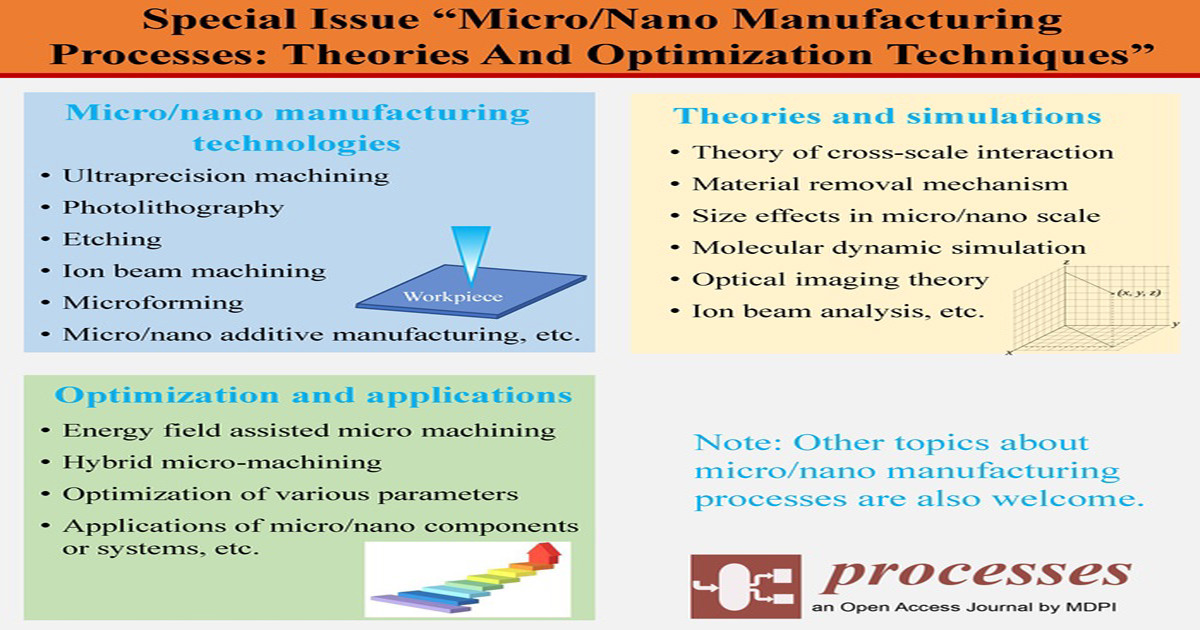Micro/Nano Manufacturing Processes: Theories and Optimization Techniques
A special issue of Processes (ISSN 2227-9717). This special issue belongs to the section "Manufacturing Processes and Systems".
Deadline for manuscript submissions: 31 May 2024 | Viewed by 14345

Special Issue Editors
Interests: ultra-precision machining; micro or nano scale machining; cutting of difficult-to-cut materials; electropusling treatment; numerical modeling; material science
Special Issues, Collections and Topics in MDPI journals
Interests: ultra-precision machining process and technology; diamond tool; smart machining; machining equipment; advanced cutting technology; design of instruments and equipment for in extreme environments
Special Issues, Collections and Topics in MDPI journals
Interests: ultra-precision machining technology; ultra-precision machining of difficult-to-cut materials; sustainable precision machining; sustainability development of precision manufacturing
Special Issues, Collections and Topics in MDPI journals
Special Issue Information
Dear Colleagues,
Manufacturing at the micro/nano scale creates many opportunities to fabricate micro and nano structures or to manufacture high-precision components, which has attracted considerable attention in fields such as optics, electronics, precision instruments, the semiconductor industry, biomedical engineering, etc. Over the years, much effort has been devoted to investigating the micro/nano manufacturing processes, but there are still some challenges to fully understanding them, since the deformation mechanism of materials at the micro/nano scales is quite different from the well-known deformation mechanisms at the macro scale. This Special Issue is dedicated to the special theories and some optimization techniques of the micro/nano manufacturing processes. Therefore, we are pleased to invite you to publish original research or review articles in the new Special Issue entitled “Micro/Nano Manufacturing Processes: Theories and Optimization Techniques”. We kindly invite you to promote the journal among your colleagues and invite them to publish in this Special Issue.
This Special Issue aims to study some essential issues about theories and optimization techniques in the micro/nano manufacturing processes. Original research articles and reviews are welcome. Research areas may include (but are not limited to) the following:
- Micro/nano manufacturing technologies such as ultraprecision machining, photolithography, etching, ion beam machining, microforming, micromolding, etc.
- Theories and simulation analyses of micro/nano manufacturing;
- Molecular dynamic simulation of nano manufacturing;
- Optimization methods of micro/nano manufacturing processes;
- Size effects in micro/nano manufacturing;
- Micro/nano additive manufacturing;
- Non-conventional micro machining processes;
- Fabrication technologies and applications of nanomaterials;
- Applications of micro/nano components or systems.
We look forward to receiving your contributions.
Dr. Zejia Zhao
Prof. Dr. Guoqing Zhang
Dr. Wai Sze YIP
Guest Editors
Manuscript Submission Information
Manuscripts should be submitted online at www.mdpi.com by registering and logging in to this website. Once you are registered, click here to go to the submission form. Manuscripts can be submitted until the deadline. All submissions that pass pre-check are peer-reviewed. Accepted papers will be published continuously in the journal (as soon as accepted) and will be listed together on the special issue website. Research articles, review articles as well as short communications are invited. For planned papers, a title and short abstract (about 100 words) can be sent to the Editorial Office for announcement on this website.
Submitted manuscripts should not have been published previously, nor be under consideration for publication elsewhere (except conference proceedings papers). All manuscripts are thoroughly refereed through a single-blind peer-review process. A guide for authors and other relevant information for submission of manuscripts is available on the Instructions for Authors page. Processes is an international peer-reviewed open access monthly journal published by MDPI.
Please visit the Instructions for Authors page before submitting a manuscript. The Article Processing Charge (APC) for publication in this open access journal is 2400 CHF (Swiss Francs). Submitted papers should be well formatted and use good English. Authors may use MDPI's English editing service prior to publication or during author revisions.
Keywords
- micro/nano manufacturing
- theories
- molecular dynamic
- optimization methods
- size effects
- micro/nano additive manufacturing
- non-conventional micro machining
- nanomaterials
- applications







